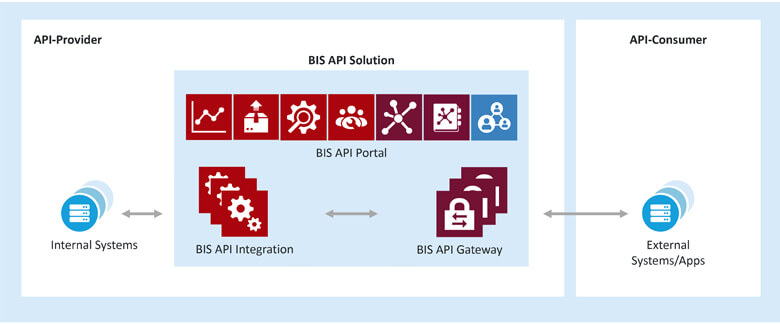APIs, The Backend Key to Data-Centric IT Architecture

The corporate world is becoming ever more digital. There are digital ecosystems springing up, digital products and business models creating new revenue streams, and thanks to increasing digitalisation, managers now have information at their fingertips, which they can quickly and easily use to help them in their strategic decision making. The key to all of this is data. However, to use data efficiently, it needs to be available in real time. And this is where APIs come in.
Discover how a data-centric architecture differs from an app-centric architecture and how the API solution in SEEBURGER’s API Business Information Suite helps you make data available to whoever needs it, regardless of the application it comes from. And best of all, find out how you can turn these real time data streams into new products and services for your customers.
Data is being generated everywhere. Let’s take the example of a car. It used to be just that – a car. You drove to get from A to B. You still do that today, however, your car is now more like a computer on wheels, constantly generating data. This is valuable data, which could be useful for many things. However, to use it, it needs to be collated at a central point so that the manufacturer can analyse it. Once that’s been done, it can give insights into driver behaviour, or reveal customer needs, all of which you can consider in your product – and company – development. This data is also a mine of inspiration for products and services to offer your customers beyond your core products. One possible digital business model could be to monetise this data by sharing it with suppliers and partners. Or, as in the following example, you could use the data to offer customers personalised service and convenience:
Turn data into individualised services for your customers
Joe Bloggs likes driving fast. However, he doesn’t spend much time thinking about boring things like whether his car is particularly roadworthy. To make sure that his tyres are replaced before they go bald, the car’s manufacturer offers its customers a helpful service. Using data generated by the vehicle, conclusions can be drawn about Joe’s driving style. Combined with information on how many miles he’s driven since his tyres were last replaced, the system displays a maintenance alert to tell Joe it’s high time to replace his tyres. However, this is just the tip of the iceberg. By networking with other partners, this maintenance alert could send a quotation – including an appointment – for a tyre change. Once Joe accepts the quote and confirms the appointment, this is saved in the calendar app on his smartphone. In a perfect world, he won’t even have to drive to a garage. Instead, a mechanic could bring a set of tyres to his home address and fit them there. What fabulous service!
This is just an example of how data which has been collated and analysed can be used to offer new, after-sales services on a product which you’ve already manufactured and sold.
How data can influence product development
Digital data can also give vehicle manufacturers valuable insights for developing their products. For example, evaluating data on the actual driving behaviour of current vehicle users means that engines can be optimised to the average driving style. There was one manufacturer who did this and discovered that the vast majority of vehicle users never drove faster than 180 km/h. This insight enabled the company to optimise their engines for this driving behaviour. It is now no longer possible to drive this vehicle faster than 180 km/h. However, this has enabled the company to make the engine more powerful while also saving a fortune in production costs.

There are two main approaches to tackling how data flows within an organisation and who has access to it: an app-centric approach or a data-centric approach. What’s the difference?
The app-centric approach
In an app-centric approach, the individual applications take centre stage. This could look like this: An organisation has various legacy systems and uses a variety of applications. The applications draw their data from the legacy systems, possibly over a central integration service bus. In order to equip existing systems to cope with changing, modern expectations and demands, whether an ERP, CRM, billing or completely different system, they are patched up with specially-written applications. These applications, however, are still drawing their data from the old legacy systems. And each application has its own data management system, stores and administrates its own (application) data, and has its own data structure. This creates data silos within the individual applications.

The data-centric approach
An alternative option is to take a data-centric approach. Data is no longer analysed by the application it has come from, rather is first collated. An integration layer in your system could connect the various legacy systems and databases. There are a number of possibilities here. Data is then collated before being passed on.
Another option would be for data to automatically flow into a decentralised data layer. This would break up data silos as the data is no longer being stored in the applications it originates from. Instead, data comes from either the data or integration layers, allowing any application to call up the data it needs for its specific tasks and analytics.
- Everyone has access to the same data. Decisions and announcements from senior management on company strategy are based on the same, up-to-date data. This should put an end to decision makers sitting at a meeting, all clutching individual reports based on their own figures.
- Taking a data-centric approach means data silos can be broken up and people base their decisions on a common data set.
- Data is no longer in a structure specific to a particular application: an API in the integration layer, extracts the data from its original structure.

Taking a data-centric approach requires a paradigm shift
For this to work, however, there needs to be a paradigm shift. An organisation’s data silos need to be broken down so that everyone has access to the same data, with processes made simpler and more transparent. A company also needs to make important decisions on the extent to which it is happy to grant external partners access to its data, which would open up new digital business opportunities. And the changes are not only technical, but require a new corporate mind-set.
- What data should be made available?
- Who can access it?
- What external data does the company need to grow? To develop new business models and ideas?
It’s no longer customised, expensively created applications which take centre stage, but data.
Data drives the integration landscape
Making data available naturally has a number of integrative implications for the current IT landscape. However, for the user, as long as s/he can easily access this data, it is irrelevant whether this is being directly called up for each request, or whether it has taken a more circuitous route and originated from several systems. The key is that whatever the backend looks like, data is being made easily accessible.
Data-driven business processes
Data drives business processes, helps in decision making and generates new business opportunities; physical and digital.
However, for this to work smoothly, data needs to be easily accessible to authorised users, simple to understand, useful and relevant. This needs to be managed and securely administrated. However, once you have a good security concept, users and developers both within and, if desired, outside the organisation, can benefit from a wealth of valuable data at their fingertips.
Securely access and make data available with the BIS API solution from SEEBURGER
SEEBURGER‘s BIS API solution is designed to deal with all the challenges associated with providing data, data integration and data security. APIs integrated through BIS let you connect internal and external systems and applications, while the BIS API gateway governs access rights and makes sure that data is provided and retrieved securely. The BIS API portal is easy-to-use API management interface which offers features such as monitoring tools and an API catalogue and can be easily extended with several useful features.

Thank you for your message
We appreciate your interest in SEEBURGER
Get in contact with us:
Please enter details about your project in the message section so we can direct your inquiry to the right consultant.
Written by: Thomas Kamper
Thomas Kamper, SVP Strategic Product Management, is responsible for strategic product initiatives related to all SEEBURGER’s business integration technology and solutions. The focus is currently on API solutions and Big Data. In addition, he is responsible for solutions that enable organizations to master challenges of visibility and to control the proper execution of digitalized business processes. Thomas rejoined SEEBURGER December 2017. Before, he worked for many years as a hands-on interim manager and business advisor supporting C-level executives within software and cloud service providers to make their strategic product initiatives successful.





